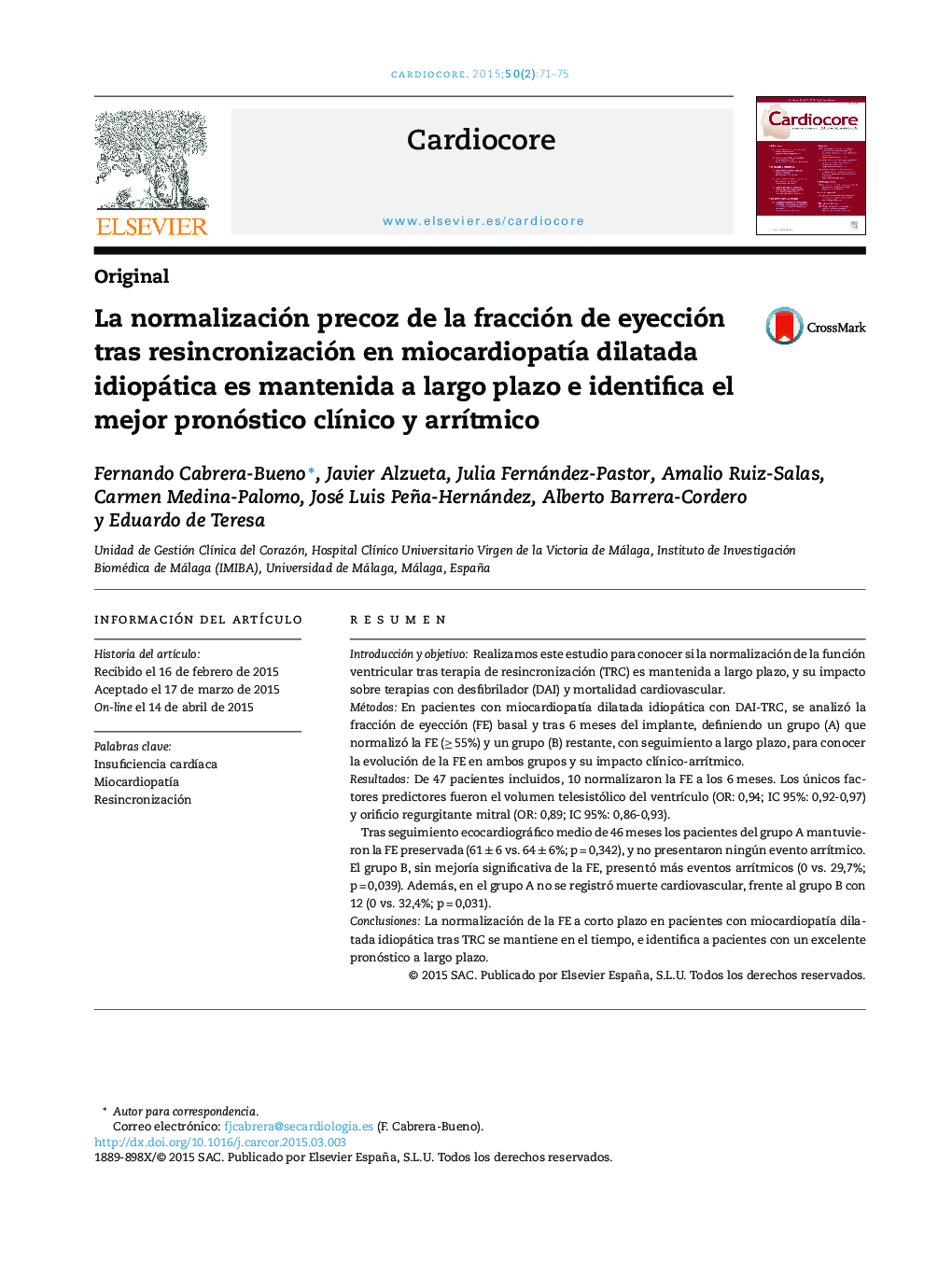| کد مقاله | کد نشریه | سال انتشار | مقاله انگلیسی | نسخه تمام متن |
|---|---|---|---|---|
| 2897352 | 1172974 | 2015 | 5 صفحه PDF | دانلود رایگان |

ResumenIntroducción y objetivoRealizamos este estudio para conocer si la normalización de la función ventricular tras terapia de resincronización (TRC) es mantenida a largo plazo, y su impacto sobre terapias con desfibrilador (DAI) y mortalidad cardiovascular.MétodosEn pacientes con miocardiopatía dilatada idiopática con DAI-TRC, se analizó la fracción de eyección (FE) basal y tras 6 meses del implante, definiendo un grupo (A) que normalizó la FE (≥ 55%) y un grupo (B) restante, con seguimiento a largo plazo, para conocer la evolución de la FE en ambos grupos y su impacto clínico-arrítmico.ResultadosDe 47 pacientes incluidos, 10 normalizaron la FE a los 6 meses. Los únicos factores predictores fueron el volumen telesistólico del ventrículo (OR: 0,94; IC 95%: 0,92-0,97) y orificio regurgitante mitral (OR: 0,89; IC 95%: 0,86-0,93).Tras seguimiento ecocardiográfico medio de 46 meses los pacientes del grupo A mantuvieron la FE preservada (61 ± 6 vs. 64 ± 6%; p = 0,342), y no presentaron ningún evento arrítmico. El grupo B, sin mejoría significativa de la FE, presentó más eventos arrítmicos (0 vs. 29,7%; p = 0,039). Además, en el grupo A no se registró muerte cardiovascular, frente al grupo B con 12 (0 vs. 32,4%; p = 0,031).ConclusionesLa normalización de la FE a corto plazo en pacientes con miocardiopatía dilatada idiopática tras TRC se mantiene en el tiempo, e identifica a pacientes con un excelente pronóstico a largo plazo.
Introduction and objectivePilot study was conducted in order to ascertain whether normalization of ventricular function after cardiac resynchronization (CRT) is maintained in the long term and its impact on ICD therapies and cardiovascular mortality.MethodsIn patients with idiopathic dilated cardiomyopathy with ICD-CRT analyzed the behavior of the ejection fraction (EF) to 6 months after implantation, defining a group (A) normalized FE (≥ 55%) and a (B) without normalizing it. We performed long-term monitoring to identify changes in left ventricular ejection fraction in both groups and their potential clinical-arrhythmic impact.ResultsOf the 47 patients included, 10 patients achieved normal EF at 6 months after implantation. The only predictors of normalization of EF were left ventricular end-systolic volume (OR: 0.94, 95% CI 0.92-0.97) and the regurgitant orifice mitral (OR: 0.89, 95% CI 0.86 to 0.93).After echocardiographic follow through 46 months patients in group A remained preserved EF (61 ± 6 vs. 64 ± 6%, P = .342), recorded by echocardiography, and showed no arrhythmic event compared to patients in group B, with no significant improvement in LVEF, had a higher incidence of arrhythmic events (0 vs. 29.7%, P = .039). Furthermore, in group A was not observed cardiovascular death compared to group B with 12 (0 vs. 32.4%, P = .031).ConclusionsNormalization of ejection fraction in the short term in patients with idiopathic dilated cardiomyopathy after CRT is maintained over time, and identifies patients with an excellent long-term prognosis.
Journal: Cardiocore - Volume 50, Issue 2, April–June 2015, Pages 71–75